Book Review- “The Beast Must Die” by Gav Thorpe
 One of the reasons why I’ve enjoyed Black Library/Games Workshop’s 12 part “The Beast Arises” storyline is that they don’t often read like standard Warhammer 40,000 novels. There’s still great action and plenty of Space Marines, but the novels are often very political, feature a huge cast of characters, and the tense story cuts back and forth to multiple locations across the galaxy. So the first seven books have been refreshing, diverse, and fun reads. That set up a problem though for my enjoyment of book Eight, “The Beast Arises” by Gav Thorpe, which for the most part reads like a standard 40K novel. That doesn’t necessarily mean it was a bad book though. There was still plenty of elements I enjoyed, and ultimately this novel leaves the overall storyline in a much more interesting place. It’s biggest flaw is something you see with all grand, event storylines (you especially see this in comic books) it’s longer than it perhaps should be.
One of the reasons why I’ve enjoyed Black Library/Games Workshop’s 12 part “The Beast Arises” storyline is that they don’t often read like standard Warhammer 40,000 novels. There’s still great action and plenty of Space Marines, but the novels are often very political, feature a huge cast of characters, and the tense story cuts back and forth to multiple locations across the galaxy. So the first seven books have been refreshing, diverse, and fun reads. That set up a problem though for my enjoyment of book Eight, “The Beast Arises” by Gav Thorpe, which for the most part reads like a standard 40K novel. That doesn’t necessarily mean it was a bad book though. There was still plenty of elements I enjoyed, and ultimately this novel leaves the overall storyline in a much more interesting place. It’s biggest flaw is something you see with all grand, event storylines (you especially see this in comic books) it’s longer than it perhaps should be.
Pretty much all of the action takes place on the infamous world of Ullanor. It’s of course famous for the Imperium of Man’s ultimate victory against the Orks back before the Horus Heresy, and now the new Ork empire besieging the galaxy has chosen it as the home base for their galactic onslaught. The book opens with a massive battle force of Space Marines, Imperial Guard, Imperial Navy, and Adeptus Mechanicus hoping to end the resurgent Ork threat for good by traveling to Ullanor and killing the Ork’s leader, “The Great Beast.”
That’s a pretty potent set up, and there are some great action sequences, but the middle half of the book is kind of a slog and feels a bit repetitive with the Orks constantly gaining the upper hand. I think part of the reason those sections were difficult for me is we spent a lot of time with some Adeptus Mechanicus characters and some Imperial Guard forces. Those characters left me flat. I like Ad Mech and Guard too. It’s just the members of those factions that Thorpe had us spend time with weren’t as interesting or fleshed out as the characters he was especially good at writing.
Because “The Beast Must Die” is primarily a war novel you don’t get much of the  political or espionage characters from the previous novels that I’ve grown to really enjoy like Assassin Grandmaster, Drakan Vangorich, or the leaders of the Imperial Inquisition. You do get, Vangorich’s chief assassin though, Esad Wire AKA Beast Krule and I loved the parts with him.
political or espionage characters from the previous novels that I’ve grown to really enjoy like Assassin Grandmaster, Drakan Vangorich, or the leaders of the Imperial Inquisition. You do get, Vangorich’s chief assassin though, Esad Wire AKA Beast Krule and I loved the parts with him.
Thorpe also did a great job with his Space Marine cast. The zealotry of Black Templars High Marshall Bohemond made for some kick-ass action scenes, some intense dramatic beats, and even some humorous scenes. Thorpe also write Lord Commander Koorland very well. His evolution over the course of the series has been one of the best parts of this storyline.
For me though, the most interesting character in “The Beast Must Die” was the Primarch, Vulkan. Vulkan is my favorite Primarch and I think Thorpe really did him justice. In the novel the Primarch of the Salamanders chapter of Space Marines comes off as both this divine figure of awesome power and a very human seeming one. That’s because in his actions and later words you see Vulkan is wrestling with the fundamental aspect of his existence; being an immortal warror. He’s been fighting for thousands of years and is tired. He’s stoic about it though and does his duty.
There’s some spectacular, fun, action sequences with Vulkan and the other Space Marines that I don’t want to spoil. The last and most bombastic one leads to some interesting revelations that makes me excited to read more of “The Beast Arises.” Those relations also cast some new light on the middle portions of the book. So there was a reason why “The Beast Arises” had to sort of read like a typical Warhammer 40,000 novel.
Ultimately, it wasn’t my favorite entry in this series, but it was still a pretty enjoyable read.
Book Review- “Dark Sacred Night” by Michael Connelly
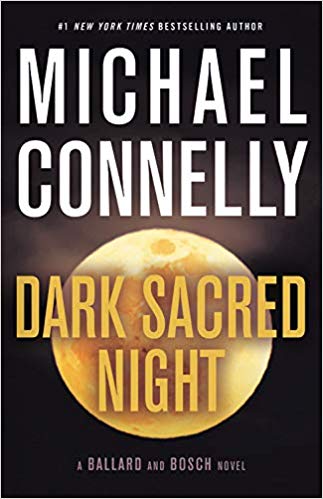 I’m a life long fan of superhero comics, and one of the reasons for that is because of the idea of the shared universe; where diverse characters like Superman and Batman or Captain America and Wolverine can cross paths, have misunderstandings, and even team up to fight evil. Watching those characters with clearly established voices and ideas clash and come together leads to fun and fascinating stories. So I was pretty excited early on to see the idea of a shared universe pop up in a much more realistic, gritty, and grounded setting; the crime novels of Michael Connelly. Connelly has made great use of the dynamic between his original series character Harry Bosch and Bosch’s half brother, the Lincoln Lawyer Mickey Haller. And in his latest novel “Dark Sacred Night” he introduces readers to a new and fascinating dynamic; the one between Harry Bosch and the writer’s newest creation LAPD Detective Renee Ballard, who readers first met last year in “The Late Show.” The result is a pretty powerful crime novel that enriches both characters.
I’m a life long fan of superhero comics, and one of the reasons for that is because of the idea of the shared universe; where diverse characters like Superman and Batman or Captain America and Wolverine can cross paths, have misunderstandings, and even team up to fight evil. Watching those characters with clearly established voices and ideas clash and come together leads to fun and fascinating stories. So I was pretty excited early on to see the idea of a shared universe pop up in a much more realistic, gritty, and grounded setting; the crime novels of Michael Connelly. Connelly has made great use of the dynamic between his original series character Harry Bosch and Bosch’s half brother, the Lincoln Lawyer Mickey Haller. And in his latest novel “Dark Sacred Night” he introduces readers to a new and fascinating dynamic; the one between Harry Bosch and the writer’s newest creation LAPD Detective Renee Ballard, who readers first met last year in “The Late Show.” The result is a pretty powerful crime novel that enriches both characters.
“Dark Sacred Night” is both a team up story and a tale about Bosch and Ballard’s separate worlds. That’s established early on as the first few chapters are from Ballard’s point of view. The next few are from Bosch’s and then Connelly alternates perspectives throughout the book. It gives the story a nice flow and really allows the reader to get deep into the heads of both protagonists. Ballard is in a better place after “The Late Show.” Harry though is still dealing with some of the fallout from the end of Connelly’s last Bosch novel “Two Kinds of Truth.” Plus he’s also having to contend with the fact that he’s getting older and only has so many years left as a police detective.
If you’re coming to “Dark Sacred Night” having only read “The Late Show” you  won’t be lost. Connelly does a great job catching new readers up on what Bosch is dealing with. If you’re a Bosch fan though it’s nice to see some connective tissue from the last book, and it makes “Dark Sacred Night” even more emotionally resonant. And if you’re a Bosch fan whose not familiar yet with Renee Ballard “Dark Sacred Night” is a great introduction to the character. After you complete it you’ll want to circle back and pick up “The Late Show.”
won’t be lost. Connelly does a great job catching new readers up on what Bosch is dealing with. If you’re a Bosch fan though it’s nice to see some connective tissue from the last book, and it makes “Dark Sacred Night” even more emotionally resonant. And if you’re a Bosch fan whose not familiar yet with Renee Ballard “Dark Sacred Night” is a great introduction to the character. After you complete it you’ll want to circle back and pick up “The Late Show.”
Much of the action in “Dark Sacred Night” involves Bosch and Ballard coming together to work a cold case, but their investigations are often disrupted by their regular jobs. Renee’s work almost plays out as sort of an anthology of interrelated short stories. You get to see her tackle several different things that pop up during Hollywood’s late night hours. It makes for some pretty fun and insightful reading into what an LAPD detective has to deal with. Bosch’s solo portions of the novel deal with his work for the San Fernando Police Department where he investigates the cold case murder of shot caller in a local gang. That investigation spirals out of control and takes Harry to some dark and dangerous places.
So Bosch’s journey as a character in “Dark Sacred Night” is especially poignant, powerful and epic. It changes him. Ballard also grows. So like the best team up stories “Dark Sacred Night” leaves both of its heroes in very interesting places. I can’t wait to see where Connelly takes them next.
Book Review- Meddling Kids by Edgar Cantero
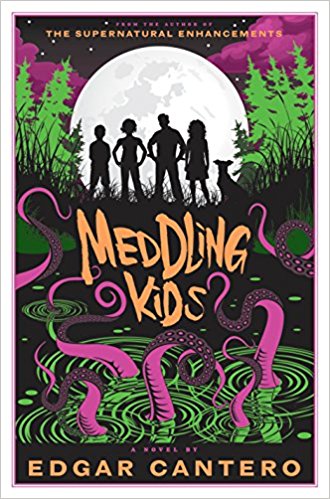 One of the reasons I love speculative and genre fiction is the crazy over the top premises. You see it all the time in comics like Marvel’s “Weapon H” series which features a titular character with the powers of both the Hulk and Wolverine or the company’s “Cosmic Ghost Rider” mini-series where the Punisher has been given both the demonic powers of the Ghost Rider and the cosmic might of a Herald of Galactus. Those series work because they full on embrace the fun of their premises and they ground their stories with fascinating and real feeling characters. I just finished reading a prose novel that did the same thing; Edgar Cantero’s “Meddling Kids which is essentially Scooby-Doo meets the Cthulhu mythos. And yes it’s as crazy and as fun as it sounds.
One of the reasons I love speculative and genre fiction is the crazy over the top premises. You see it all the time in comics like Marvel’s “Weapon H” series which features a titular character with the powers of both the Hulk and Wolverine or the company’s “Cosmic Ghost Rider” mini-series where the Punisher has been given both the demonic powers of the Ghost Rider and the cosmic might of a Herald of Galactus. Those series work because they full on embrace the fun of their premises and they ground their stories with fascinating and real feeling characters. I just finished reading a prose novel that did the same thing; Edgar Cantero’s “Meddling Kids which is essentially Scooby-Doo meets the Cthulhu mythos. And yes it’s as crazy and as fun as it sounds.
In “Meddling Kids” Cantero introduces readers to an estranged group of friends who spent their summers investigating the mysteries of a small pacific Northwest Town named Blyton Hills. Their investigative endeavors lead them to become local celebrities and also exposed the wrongdoings of a number of costume clad malefactors. When the story picks up, the now adult members of the former Blyton Summer Detective Club are haunted by the memories of their last case, which seemed to involve a lake monster and a haunted island mansion, but possibly involved something much more horrific.
The cast of former kid detectives is pretty great. There’s Kerri, the aspiring scientist who is currently a barmaid; Andy the tomboy turned drifter who sets out to get the gang back together and find out what really happened at the mansion on their last case; Keri’s cousin Nate, who is currently a resident of an asylum that fans of Cthulhu Mythos fiction will find familiar; and Peter who is dead and might be a ghost. All of these characters have fun personality traits and character flaws. The dynamic they have together is part of the fun of reading “Meddling Kids.”
who is currently a barmaid; Andy the tomboy turned drifter who sets out to get the gang back together and find out what really happened at the mansion on their last case; Keri’s cousin Nate, who is currently a resident of an asylum that fans of Cthulhu Mythos fiction will find familiar; and Peter who is dead and might be a ghost. All of these characters have fun personality traits and character flaws. The dynamic they have together is part of the fun of reading “Meddling Kids.”
Earlier I mentioned this book was basically Scooby-Doo meets Cthulhu so many of you might be wondering is there a dog main character? And the answer is of course, yes! His name is Tim. He’s a Weimaraner. He’s actually one of my favorite characters in the book. Cantero writes him so well. He provides moments of comfort and comedy. He’s so lovable and such a good boy.
A dog isn’t the only Scooby-Doo element to make it into “Meddling Kids” either. The Blyton Hills Detective Club had a number of Rube Goldberg style plans for catching bad guys. And some do appear in their present day exploits. They’re fun and believable though and add some humor elements to balance out the Lovecraftian horror.
Cantero also makes great use of the Cthulhu Mythos once the kids arrive back in Blyton Hills. It begins with a run in with a horrific monstrosity and then things escalate to apocalyptic levels. So there’s a great sense of scope and scale reminiscent of shows like “Stranger Things”where the cast have to save both their idyllic small town and the world.
Speaking of towns, Blyton Hills is a fun place to visit. When the grown up kids of the Detective Club return it’s fallen on hard times, but still has a quaint charm. It feels like home to both the characters and the reader. Plus, Cantero provies a lot of fun legends about the town to make the Cthulhu mythos elements organic. The town is also populated by a great cast of characters including a former bully, and Captain Al, a retired Air Force veteran who was one of the detectives few adult confidants when they were kids.
I’m keeping mum about a lot of the elements in “Meddling Kids” because I don’t want to ruin the surprises. I will say though it’s an incredibly fun, fantastically placed cocktail of horror, adventure, and comedy. And it also takes a refrshing and more hopeful spin on the cynicism of Lovecraftian Cosmic Horror. It beautifully illustrates that the best defense we humans have against horror (Cosmic or otherwise) is the bonds we have with each other.
So, “Meddling Kids” was a hell of a read. Making it even more remarkable is the fact that Cantero is not a native English speaker. This is the first book I’ve read by him and I can’t wait to read more.
Book Review- “The Hunt for Vulkan” by David Annandale
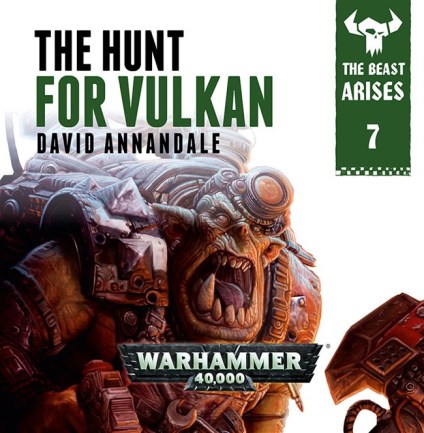 It’s been a while since I reached the halfway point of Games Workshop/Black Library’s epic 12 part “The Beast Arises” storyline. Not because I’m not a fan. It’s just life and and an ever expanding reading pile happened. So I was excited to finally get a chance to get back into the ork fighting action with “The Hunt for Vulkan” by David Annandale. It’s book 7 in the storyline. I worried though that my months away from the saga make it harder to get back into. Turns out all my worries were for nothing because “In the Hunt for Vulkan” Annandale welcomed me back into the “War of the Beast” with open arms. It was a fun tale bursting with action that made me eager to dig into the back half of the 12 part tale.
It’s been a while since I reached the halfway point of Games Workshop/Black Library’s epic 12 part “The Beast Arises” storyline. Not because I’m not a fan. It’s just life and and an ever expanding reading pile happened. So I was excited to finally get a chance to get back into the ork fighting action with “The Hunt for Vulkan” by David Annandale. It’s book 7 in the storyline. I worried though that my months away from the saga make it harder to get back into. Turns out all my worries were for nothing because “In the Hunt for Vulkan” Annandale welcomed me back into the “War of the Beast” with open arms. It was a fun tale bursting with action that made me eager to dig into the back half of the 12 part tale.
“The Hunt for Vulkan” features a huge cast of characters, but it mainly follows a core cast of intriguing ones. At the center of the tale is Koorland, the last member of the Imperial Fists Space Marine chapter who we met back in the opening installment of this series. Part of the highlight of “The Beast Arises” has been Koorland’s journey as a character from survivor to Lord Commander of the Imperium. In “The Hunt for Vulkan” we get a chance to see him reflect on that journey and deal with some of the ghosts that still haunt him after the tragic loss he experienced in book one. We also get to see his growth as a political and military leader.
Annandale opens the book with a crisis on Mars that threatens to turn the Imperium and the Adeptus Mechanicus against each other. That’s where we get to see Koorland’s mettle as a political leader tested. I was riveted watching him face off against the Mechanicus’ Fabricator General in a game of chicken. In the latter half of the book you get to see Koorland back on the battlefield as he leads a vast Imperium strike force in the titular “Hunt for Vulkan.”
The other major character of “The Hunt for Vulkan” is Thane, the Chapter Master of the Space Marine Legion known as the Fists Exemplar. We primarily get to see Thane on the battlefield in this book, but he’s a fun character to watch in a fight, and this novel also continues his growth from the previous ones. Some other character moments I enjoyed included the ones we spent with the crew of an Imperial Navy ship as it tried to survive a void battle against an ork armada and an ork Attack Moon, and checking back in with a Loyalist Space Marine Legion that’s been forced into an alliance with the Traitorous Iron Warriors Legion.
the Space Marine Legion known as the Fists Exemplar. We primarily get to see Thane on the battlefield in this book, but he’s a fun character to watch in a fight, and this novel also continues his growth from the previous ones. Some other character moments I enjoyed included the ones we spent with the crew of an Imperial Navy ship as it tried to survive a void battle against an ork armada and an ork Attack Moon, and checking back in with a Loyalist Space Marine Legion that’s been forced into an alliance with the Traitorous Iron Warriors Legion.
The best character moments for me though were the few ones we got to spend with my favorite Primarch, Vulkan. Annandale does let us get inside in Vulkan’s head in several powerful and inspiring moments. and he nails the character’s voice. Vulkan’s thoughts and deeds in the novel illustrate why he and the Salamanders are my favorite Loyalist Space Marine Legion and Primarch.
The other thing I loved about “The Hunt for Vulkan” was of course the wall-to-wall action of the book. The novel opens with an intense and desperate battle between the forces of the Imperium and then the latter 2/3 are an epic war on a crumbling planet. Annandale is fantastic at these scenes too. The book’s battles were full of powerful, bone crunching descriptions, and twists and turns that chilled me and made me cheer.
So, with “The Hunt For Vulkan” I was plunged back into the excitement of “The Beast Arises.” It was also another fantastic 40K book from Annandale. I’ve read three Black Library books by him now and I’ve loved everyone.
Book Review- “Sadie by Courtney Summers
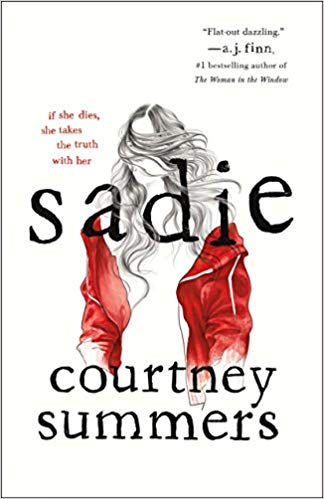 I don’t know why I continue to underestimate YA fiction, especially of the crime genre. I mean one of my favorite shows of all time, “Veronica Mars”, is about a teenage P.I. and it’s pretty noir. I guess I just have this weird pre-conceived notion that Young Adult prose novel’s featuring younger protagonists don’t make for hard hitting crime stories. Kristi Belcamino proved me wrong with her fantastic YA debut, “City of Angels.” And Courtney Summers once again proves me wrong with her new YA novel “Sadie.” I just finished reading it. It’s a powerful, fantastically paced, poignant, original crime novel that reads like a mash up of Andrew Vachss, the Jonathan Lethem novel “Motherless Brooklyn” and
I don’t know why I continue to underestimate YA fiction, especially of the crime genre. I mean one of my favorite shows of all time, “Veronica Mars”, is about a teenage P.I. and it’s pretty noir. I guess I just have this weird pre-conceived notion that Young Adult prose novel’s featuring younger protagonists don’t make for hard hitting crime stories. Kristi Belcamino proved me wrong with her fantastic YA debut, “City of Angels.” And Courtney Summers once again proves me wrong with her new YA novel “Sadie.” I just finished reading it. It’s a powerful, fantastically paced, poignant, original crime novel that reads like a mash up of Andrew Vachss, the Jonathan Lethem novel “Motherless Brooklyn” and
the movie “Winter’s Bone.” Yes, it’s that good.
In “Sadie,” Summers is telling a mystery story on two fronts and two formats. The first is told via the transcripts of a podcast called “The Girls” and in it we follow the exploits of host, West McCray, who is reluctantly dragged into the hunt for a missing girl. Her name is Sadie Hunters. She’s 19 years old and she up and vanished one day several months after her younger sister Mattie was murdered. McCray is called in after Sadie’s abandoned car turns up.
The second mystery is told from Sadie’s point of view. We go with her on her cross-country journey away from home and on a mysterious and very personal quest that unfolds over the course of the story. That set up, and the contrast between the two narratives makes “Sadie” an exciting novel to read. Summers used the different view points to feed into the two narratives perfectly. We’d get a chapter that cliff hangered from Sadie’s point of view and then we’d go with West McCray as he investigated the aftermath and tried to make sense of things.
“Sadie” also works because the title characters is fascinating. She’s haunted by the death of the one person who meant the world to her, her younger sister. She’s also tragically someone who never got to be a kid because of her family situation and some other things we discover as the novel unfolds. Making Sadie even more fascinating is the fact that she has a stutter. Since her portions of the novel are told from her perspective we get to hear how she feels about that, and how she’s affected by the way people treat her because of it. It’s something that you don’t often see in a book and it made an already empathetic character even more relatable.
death of the one person who meant the world to her, her younger sister. She’s also tragically someone who never got to be a kid because of her family situation and some other things we discover as the novel unfolds. Making Sadie even more fascinating is the fact that she has a stutter. Since her portions of the novel are told from her perspective we get to hear how she feels about that, and how she’s affected by the way people treat her because of it. It’s something that you don’t often see in a book and it made an already empathetic character even more relatable.
West McCray is also an interesting character. At the beginning I admired him because he served as the dogged detective, but in the second half of the book you learn more personal details about him that makes his quest to find Sadie even more emotionally resonant.
Summers also populates “Sadie” with a whole host of fascinating and very realistic characters that we meet in both McCray’s and Sadie’s journeys. My favorites included Javi, a kind teenage boy Sadie encounters; Cat, a hitchhiker she picks up; and May Beth, a sort of surrogate mother to Sadie who runs the trailer park she lived in. There are also some very sinister figures who hang over the story in “Sadie.” I don’t want to say much about them because they’re involved in some of the most powerful and poignant reveals in the story.
Those sinister figures and their actions infuse “Sadie” with a compelling tone of creeping dread. As the story unfolds you want to learn more about the mysteries of the novel, but there’s a sense that those truths will be haunting and unsettling.
The book is also very moving too. It’s kind of an epic look at the power of familial love; how it can fuel us, keep us on our feet after enduring physical and emotional punishment, and consume us.
So, with “Sadie” Courtney Summers proves to me once again that YA crime fiction can be just as moving, powerful and haunting as crime stories intended for an adult audience. It’s a hell of a read.
Book Review- “Prospero Burns” by Dan Abnett
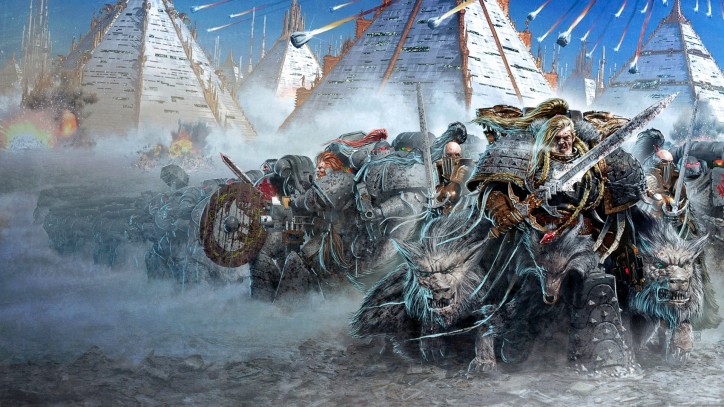 I love the world of Warhammer 40,000. It’s a rich and fascinating universe. I currently have two armies to play in the 8th edition of the game (I play Salamanders and Thousand Sons) I even bought Games Workshop’s newest skirmish version of 40K, “Kill Team” (Which is a great and fairly cheap way to get your feet wet in the world of 40K) The reason I’m such a huge fan though is the fabulous work done by the authors of the fiction arm of Games Workshop, the Black Library.
I love the world of Warhammer 40,000. It’s a rich and fascinating universe. I currently have two armies to play in the 8th edition of the game (I play Salamanders and Thousand Sons) I even bought Games Workshop’s newest skirmish version of 40K, “Kill Team” (Which is a great and fairly cheap way to get your feet wet in the world of 40K) The reason I’m such a huge fan though is the fabulous work done by the authors of the fiction arm of Games Workshop, the Black Library.
The work of one specific Black Library author though, Dan Abnett, brought me into the World of 40K. I was a huge fan of his comic work and I’ve been lucky enough to interview him as a journalist on several different occasions. He’s a super nice guy. So one day I picked up my library’s copy of “The Eisenhorn Omnibus” and I was hooked. I’ve thoroughly enjoyed everything 40K I’ve read by Abnett and I think his novel, “Legion,” is one of the best entries in the 40K prequel series, “The Horus Heresy,” that I’ve read so far. So I was especially excited to read his novel “Prospero Burns,” which is the 15th entry in the series.
Part of the reason I was excited is because the last Horus Heresy novel I read was Graham McNeill’s “Thousand Sons.” That book made me love the Thousand Sons and its a large part of the reason why I have a Thousand Sons army to play 40K. One of the most tragic and heartbreaking elements of that story was the burning of Prospero, the Thousand Sons’ homeworld, by the Space Marine legion known as The Space Wolves.
So, I was curious to see what that historical moment looked like from The Space Wolves perspective and in “Prospero Burns” Abnett gives us that, but he also gives us so much more. The result is a powerful, fun, exciting, and poignant read even if you’re a Thousand Sons fan and player (like me)
I feel the best 40K and Horus Heresy novels are the ones that take deep dives into the cultures that their protagonists hail from. And in “Prospero Burns” Abnett does that. You’re given a sense of the true, savage purpose of the Space Wolves. You’re allowed to appreciate their sense of loyalty to that purpose and their Emperor. You’re also allowed to feel sorry for what that loyalty does to them and angry at the tragic mistakes it causes them to make.
the cultures that their protagonists hail from. And in “Prospero Burns” Abnett does that. You’re given a sense of the true, savage purpose of the Space Wolves. You’re allowed to appreciate their sense of loyalty to that purpose and their Emperor. You’re also allowed to feel sorry for what that loyalty does to them and angry at the tragic mistakes it causes them to make.
Best of all though is you’re allowed to see these superhuman warriors in a more human light. That’s because you learn the types of stories that entertain and enthrall the Space Wolves in quieter moments when they’re sitting around a campfire or when they’re trying to provide some final moments of comfort to a mortally injured comrade.
This exploration of Space Wolf culture is done primarily through the eyes of a scholar named Kasper Hawser. He’s a fascinating almost Indiana Jones style character and like the Remembrancer (scholarly types) characters in other “Horus Heresy” novels he’s a great character and his perspective on the actions and culture of the Space Wolves is fascinating.
Abnett also uses Kasper to provide some very cool insights into what Earth was like before and several years after The Emperor of Mankind unified it. Because throughout the book were given glimpses of Hawser’s past. Those flashback sequences are also tied into the larger plot in a way that I won’t spoil because it’s a cool reveal.
“Prospero Burns” is also a fun adventure that brushes up against new and classic elements of 40K lore. Some of my favorite new characters and concepts include Longfang, the Space Wolves Rune Priest that Hawser spends some time with, and the Quietude; an interstellar empire that very much felt like a 40K version of the classic Star Trek villains, the Borg.
At first there might not seem like a lot for fans looking into insight at larger and classic 40K characters and lore. Patient readers will be rewarded though. Quite a few familiar faces, including Space Wolf Primarch Leman Russ, appear in the second half of the book. Plus Abnett adds some excitement and intrigue to big events like the Council of Nikaea and the titular Burning of Prospero.
So “Prospero Burns” is a fantastic book that is many things. It’s primarily a sci-fi adventure story and cultural study. As the book unfolds though Abnett organically adds layers to the narrative that make it even more enjoyable. So it’s also a spy/conspiracy story, a tale of supernatural horror, and tragedy in almost the classical sense of the word. All of those elements combine to make “Prospero Burns” a hell of a read.
Book Review- Blackout by Alex Segura
 There’s a lot of reasons why we read a series of crime fiction novels. They give us exciting action sequences, nuanced characters we root for and against (often back and forth), and moments of powerful and gritty drama. All of that is sort of the frosting on the metaphorical cake though. The real reason we read a good crime fiction series is to go on a journey. We want an identifiable character we can root for, scream at and empathize with when they fall, and stand up and cheer when they get back up and keep fighting. Alex Segura understands that. It’s why his series of novels starring private detective Pete Fernandez have been so good, and it’s why the latest, Blackout (which I just finished) could be his best one yet.
There’s a lot of reasons why we read a series of crime fiction novels. They give us exciting action sequences, nuanced characters we root for and against (often back and forth), and moments of powerful and gritty drama. All of that is sort of the frosting on the metaphorical cake though. The real reason we read a good crime fiction series is to go on a journey. We want an identifiable character we can root for, scream at and empathize with when they fall, and stand up and cheer when they get back up and keep fighting. Alex Segura understands that. It’s why his series of novels starring private detective Pete Fernandez have been so good, and it’s why the latest, Blackout (which I just finished) could be his best one yet.
In Blackout, Segura gives us a novel of epic scope and scale. You get cults, the mob, a murder investigation that Pete interacts with at three different points in his life, political intrigues, assassinations, and a climax that takes place in the eye of a hurricane. So going back to my earlier (and perhaps tired and cliched) metaphor, the frosting on Blackout is exciting and great. But what makes all that fun stuff especially resonant is the emotional journey that’s come before and continues in this novel.
To talk in too much detail would spoil a lot of things, but I can say this is a book that offers long term payout to readers of the other books. Over the course of the story it’s clear that Pete grows. He confronts somethings and makes some realizations that makes him an even more fascinating character and makes the end of the Blackout extremely powerful.
And it’s not just Pete that’s great in this book. Over the course of the novels I’ve  come to care for his friends like former FBI Agent Robert Harras. I’m especially attached his pal with a criminal past, Dave Mendoza; and his partner Kathy Bentley. The first two have some great moments in Blackout. I especially love some of the revelations we get into Dave’s past which make him even more intriguing. For me, though the truly awesome supporting character in this story is Kathy.
come to care for his friends like former FBI Agent Robert Harras. I’m especially attached his pal with a criminal past, Dave Mendoza; and his partner Kathy Bentley. The first two have some great moments in Blackout. I especially love some of the revelations we get into Dave’s past which make him even more intriguing. For me, though the truly awesome supporting character in this story is Kathy.
We’ve got to see Kathy grow too over the course of the Peter Fernandez books and she’s become amazing. In Blackout she’s insightful, tough, compassionate, and the perfect person to play Pete off of. Their dynamic together is fun and heartfelt.
So, if you haven’t read any Pete Fernandez books do yourself a favor, go back and start at the beginning. By the time you get to Blackout you’ll see you’ve been part of a truly special journey. And best of all that journey is far from over! The final pages of Blackout will have you desperately longing to see where Segura takes Pete Fernandez next.
Book Review-Forges of Mars Omnibus by Graham McNeill
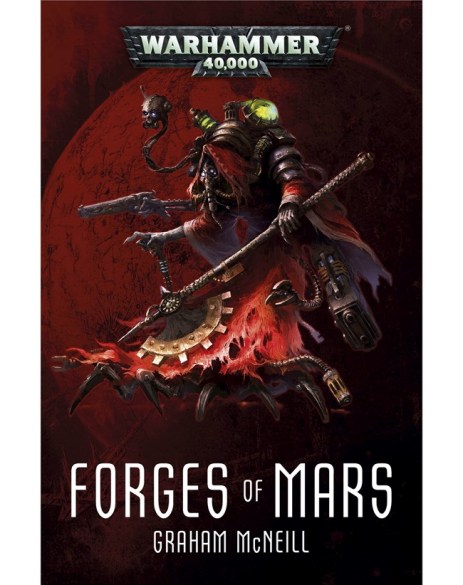 One of the great things about the world of Warhammer 40,000 is all its fascinating factions. Its easy to think one is not for you, but like comics all it takes is the right writer to illustrate a group’s potential. For me that faction was the the Tech-Priests of the Adeptus Mechanicus, but then I read Graham McNeill’s Horus Heresy novel, Mechanicum. In it McNeill showed me the Admech are a fascinating group of characters and there’s a bunch of interesting stories to be told with them. So I thought I’d see what he could do with a whole trilogy of Adeptus Mechanicus novels and picked up the Forges of Mars omnibus, which contains the novels Priests of Mars, Lords of Mars, and Gods of Mars, as well as the short story Zero Day Exploit.
One of the great things about the world of Warhammer 40,000 is all its fascinating factions. Its easy to think one is not for you, but like comics all it takes is the right writer to illustrate a group’s potential. For me that faction was the the Tech-Priests of the Adeptus Mechanicus, but then I read Graham McNeill’s Horus Heresy novel, Mechanicum. In it McNeill showed me the Admech are a fascinating group of characters and there’s a bunch of interesting stories to be told with them. So I thought I’d see what he could do with a whole trilogy of Adeptus Mechanicus novels and picked up the Forges of Mars omnibus, which contains the novels Priests of Mars, Lords of Mars, and Gods of Mars, as well as the short story Zero Day Exploit.
I got what I wanted and then some. Because Forges of Mars is full of a whole host of fascinating characters not just members of the Admech. Plus each book in the series ups the scope and scale . So Gods of Mars is a story full of grand, epic action, and character payouts.
The Forges of Mars omnibus starts out as a tale of exploration. So essentially McNeill is taking a Star Trek style story and giving it a 40K spin.His story is about an Adeptus Mechanicus expedition for a missing ship that traveled outside the known galaxy thousands of years ago. The flagship of this new expedition is a massive and ancient vessel known as the Speranza. It’s almost like a planet and much of the action in the trilogy unfolds in its labyrinthine layout. It’s a pretty fascinating locale that’s almost a character unto itself.
Walking the halls of the Speranza are a diverse group of Adeptus Mechanicus tech-priests. First and foremost is of course the expedition leader, Lexell Kotov. He’s surrounded himself with a number cold and career focused tech-priests like Tarkis Blaylock. What’s great about those characters though is how nuanced they are. Over the course of the trilogy you get moments that show them at their worst, but they also get genuine moments of heroism and altruism. Plus there are some very noble, grounded, and easy to like tech-priests like the father and daughter team of Vitali and Linya Tychon. Their noble nature and genuine affection for each other made them some of my favorite characters in the trilogy.
The nature of the Kotov expedition allows McNeill to expand the cast of Forges of  Mars beyond tech-priests and include diverse characters from all over the Imperium of Man. Accompanying the expedition are a band of Black Templar Space Marines, a detachment of valiant soldiers from Cadia, a Legion of Titan war machines and their pilots, a Rogue Trader and his crew, and several normal humans press ganged into being bondsmen aboard the Speranza. But that’s not all! There’s also a crew of Eldar pursuing the Speranza.
Mars beyond tech-priests and include diverse characters from all over the Imperium of Man. Accompanying the expedition are a band of Black Templar Space Marines, a detachment of valiant soldiers from Cadia, a Legion of Titan war machines and their pilots, a Rogue Trader and his crew, and several normal humans press ganged into being bondsmen aboard the Speranza. But that’s not all! There’s also a crew of Eldar pursuing the Speranza.
As the Forges of Mars trilogy unfolds were allowed to spend time with all of these characters and see things from their perspective. So I really came to care about almost all of them. It heightened all the action scenes and made the climax of the trilogy incredibly enjoyable. There was so much payoff. The character arcs I probably enjoyed the most were the ones of Linya Tychon; Rogue Trade Roboute Surcouf who hails from the Ultramar system which means he’s kind of like James T Kirk mixed with the nobility of Steve Rogers; and Black Templar sergeant Tanna, who really goes on a journey of growth over the course of the trilogy.
I also have to mention that McNeill may have opened my eyes to the appeal of the Eldar. They are another faction that have popped up throughout the 40K novels I’ve read that I really haven’t found all that appealing. In Forges of Mars, McNeill points out how the Eldar are a damned race thanks to their creation of the Chaos God Slaanesh, but they’ve decided to sort of go down swinging and fighting against their fate. That made me see them in an entirely new light. So I may have to seek out some Eldar novels.
I don’t want to say too much about the action of the Forges of Mars trilogy because a lot of of it is shrouded in mystery with some great reveals. What I will say is the story takes readers to pretty fantastic locales like alien planets, a seemingly deserted space station, and a mysterious Forge World. McNeill also has a lot of fun with the tone of the trilogy as well. You get moments of grand adventure, character drama, cosmic horror, and over the top action. The climax of the book is an epic struggle to save the entire universe and features a number of wildly imaginative and gloriously trippy sequences.
All of that makes Forges of Mars an incredible and epic read. For me, its one of those grand trilogies that reflects all the reasons why I love the 40K universe. It’s right up there with Dan Abnett’s Eisenhorn trilogy and Aaron Dembski-Bowden’s Night Lords trilogy. It’s that good! I was already a fan of McNeill before reading this Omnibus, but now he’s one of my favorite Black Library authors.
Thoughts About Metal and Visigoth’s “The Conqueror’s Oath.”
 Regular readers of this blog may have picked up that I’m a fan of Heavy Metal music. In fact the older I get the more I love metal and all it’s varied sub genres. Part of the reason I love it is because it’s a way to cope with the sometimes soul crushing mundanity of life. Metal turns things up to 11. It makes dull, routine things epic and operatic feats. So it’s a really fun genre.
Regular readers of this blog may have picked up that I’m a fan of Heavy Metal music. In fact the older I get the more I love metal and all it’s varied sub genres. Part of the reason I love it is because it’s a way to cope with the sometimes soul crushing mundanity of life. Metal turns things up to 11. It makes dull, routine things epic and operatic feats. So it’s a really fun genre.
It’s also a genre of extreme emotions. The world is a pretty dark place these days, especially here in the suburban badlands of America where I live. Our numbskull in chief and his cronies have created a climate of cruelty, corruption, and outright stupidity. So I’m angry very often. And when I am Metal is there for me. It lets me howl at the awfulness in the world.
Metal can also pick you up and dust you off when existential dread, ennui, and depression knocks you to the floor. Power Metal is especially uplifting genre. If you take it at face value with it’s lyrics about fighting monsters and dragons it’s of course silly. I would argue it’s sublimely ridiculous, but that’s kind of the point. And I refer you back to what I was talking about earlier; how metal makes life more epic. Plus what better way to slay and confront your metaphorical demons and monster than with stirring, epic, ballads about slaying mythic monsters.
If you want a great example of that I would urge you to check out “The Conqueror’s  Oath” by Salt Lake City based power metal band Visigoth. It was released today. I’ve listened to it several times already and it helped turn a grey, bleak, snowy day into one of epic possibilities. It even made me write about music for the first time.
Oath” by Salt Lake City based power metal band Visigoth. It was released today. I’ve listened to it several times already and it helped turn a grey, bleak, snowy day into one of epic possibilities. It even made me write about music for the first time.
Conqueror’s Oath is eight, epic tracks about facing adversity with steel, courage, and honor. It will get you pumped up to confront difficult tasks, face your fears, and enjoy life. My two favorite tracks are “Hammer Forged” and “Conqueror’s Oath.” Those tracks especially are a soundtrack for going out and being awesome. It’s like a love child of the music of Dio and Henry Rollins. They’re feel good, self help songs for D&D nerds like myself. The whole album is fantastic and a great example of what’s awesome about metal
If you’re curious check out the title track from Conqueror’s Oath here.
And if you’re just curious about Metal and it’s various subgenres check out this helpful video made by the awesome, Whitney Moore
Book Review- “Bonfire” by Krysten Ritter
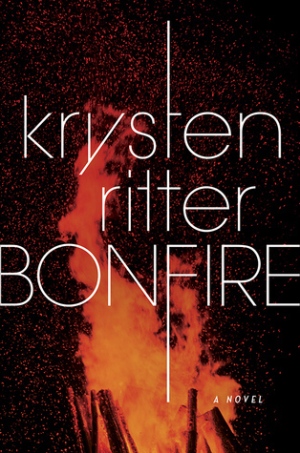 Krysten Ritter has been involved with three of my favorite crime shows of all time: “Veronica Mars,” “Breaking Bad,” and Netflix’s adaptation of Marvel Comics “Jessica Jones.” As an actress she was part of the storytelling of those shows. She helped create a character, and she got to witness how the stories on those shows were brought to life. Now I wonder if she was taking notes because I just finished Ritter’s debut novel, “Bonfire,” and it’s a pretty great first crime novel.
Krysten Ritter has been involved with three of my favorite crime shows of all time: “Veronica Mars,” “Breaking Bad,” and Netflix’s adaptation of Marvel Comics “Jessica Jones.” As an actress she was part of the storytelling of those shows. She helped create a character, and she got to witness how the stories on those shows were brought to life. Now I wonder if she was taking notes because I just finished Ritter’s debut novel, “Bonfire,” and it’s a pretty great first crime novel.
In “Bonfire” Ritter takes readers to the fictional town of Barrens, Indiana. It’s a small company town full of unpleasant ghosts and personal demons for her protagonist, an environmental lawyer named Abby Williams. It’s a town Abby escaped from, but the experiences she endured as a teenager at the hands of her family and peers still haunt her. We immediately get the sense of that, but one of Ritter’s strengths as a writer is her ability to convey a sense of place.
She makes Barrens just as horrific for us readers as it is for Abby. She believably brings to life a town swimming in literal and metaphorical sickness. The former is from possible pollution and why Abby has been forced to return home, and the latter comes from the horrific corruption and secrets that took root when Abby was a teenager and have been festering for about a decade.
Abby is a very believable and damaged protagonist. She clearly has PTSD from some of the horrible things she endured as a teenager and often drinks and makes bad decisions. You understand why because Ritter allows you to experience Abby’s memories, but memory is fleeting and subjective. Ritter has fun with that as well.
bad decisions. You understand why because Ritter allows you to experience Abby’s memories, but memory is fleeting and subjective. Ritter has fun with that as well.
We meet a number of interesting characters as Abby investigates the mysteries in Barrens like the fellow members of her legal team and some of grown up people who tormented her as a teen, but for me the most fascinating character in the book is someone Abby has returned home to find, her childhood friend turned biggest tormenter as a teen, Kaycee Mitchell. Kaycee is a mercurial and vile person, but too Ritter’s credit she’s not a cartoon. You’re given some scenes that give you insight into Kaycee’s action and even allow you to genuinely empathize with her.
Tone is another area Ritter excelled at. Abby’s investigation uncovers some truly sinister secrets about the town and some of it’s residents. So there’s also a very thrilling and palpable sense of paranoia and psychological horror.
“Bonfire” is a great debut novel about both the damage teenagers can do to each other and the horrific secrets that can hide in small towns. The book is a kickoff to what I hope will be a second successful career for Ritter because I’m eager for both the second season of “Jessica Jones” and to see what she does next as a novelist.